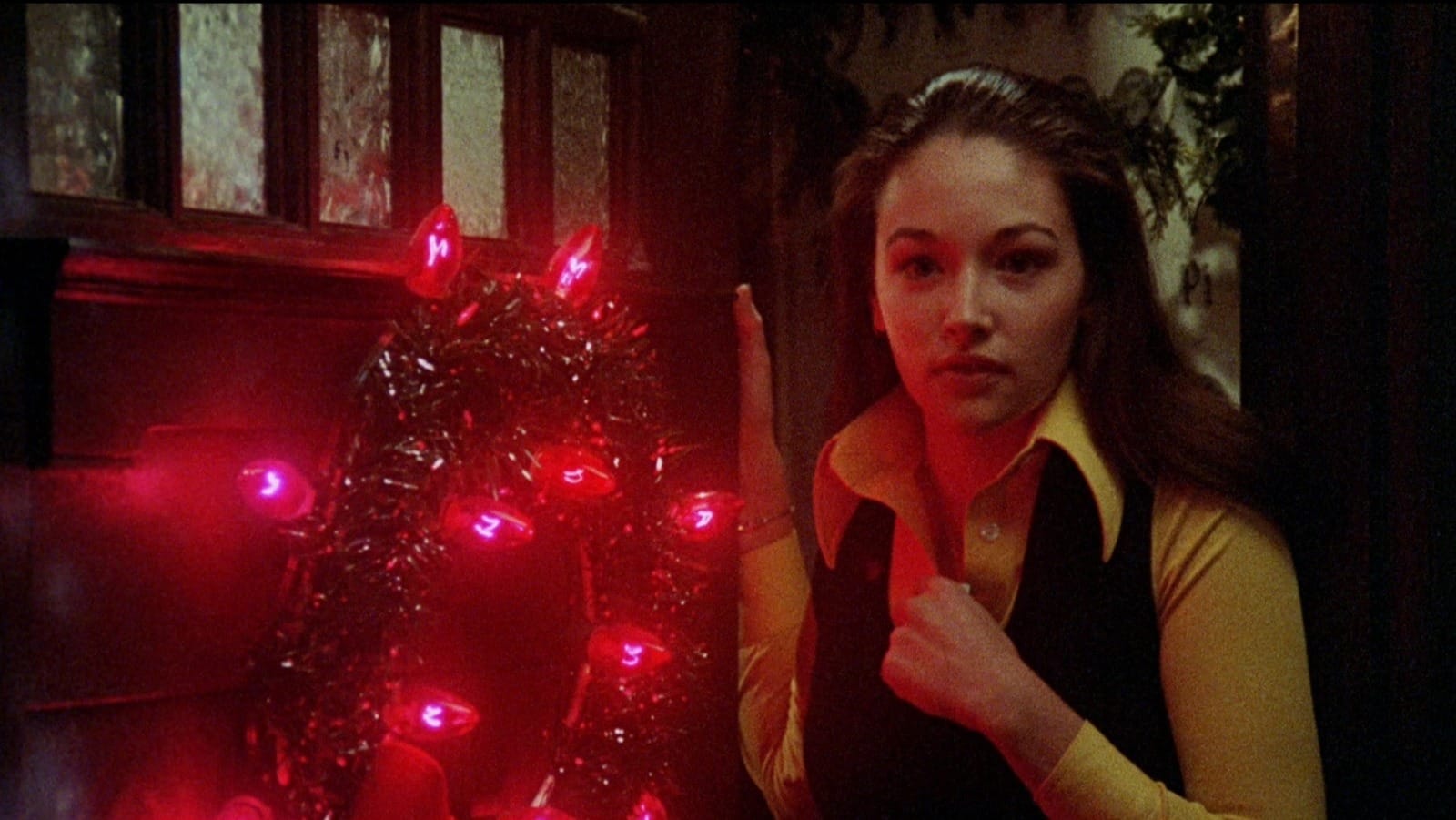Prancer, Dancer, Slasher and Vixen: Black Christmas
Black Christmas (1974, Canada, 98 mins)
Directed by: Bob Clark
Written by: Roy Moore
Produced by: Bob Clark
Cinematography: Reginald H. Moore
Edited by: Stan Cole
Cast: Olivia Hussey, Keir Dullea, Margot Kidder, John Saxon, Marian Waldman
Tracing the development of the slasher film is a thorny process. Psycho and Peeping Tom (both 1960) are frequently cited as important precursors to the genre, introducing the murderous psychosexuality which would come to define the slasher.
The film most widely considered the ‘first’ slasher is John Carpenter’s Halloween (1978) and it is not difficult to see why. Halloween not only codifies the structural elements which define slasher filmmaking, it also establishes the conservative political landscape which subsequent slashers find themselves in.
Halloween came under fire when it was released as feminist critics felt that the film effectively punished female sexuality. John Carpenter himself disagreed, arguing that “if you turn it around, the one girl who is the most sexually uptight just keeps stabbing this guy with a long knife. She's the most sexually frustrated. She's the one that killed him. Not because she's a virgin, but because all that repressed energy starts coming out. She uses all those phallic symbols on the guy.... She and the killer have a certain link: sexual repression”[1].
Released in 1974, Bob Clark’s Black Christmas predates Halloween by 4 years, but is undoubtedly a slasher film. Indeed, the film is a direct influence on the style and structure of Halloween, with Clark even suggesting that he came up with the basic plot of Halloween as an idea for a sequel to Black Christmas and that he had told a young John Carpenter his idea years before Halloween came to be.
Black Christmas was the culmination of a years-long effort by the flailing Canadian film industry to produce an international hit. The film was considered “perhaps the final opportunity for [Canada] to produce its first blockbuster hit”[2], with an unprecedented CAD$600,000 being contributed to the film by the Canadian government and several Canadian production companies, making it “the most costly state-subsidized production in Canadian history”[3].
With so much riding on the success of the film, the powers behind its creation sought to incorporate elements of films which had been major hits in the US in the years preceding the release of Black Christmas. They noted “the enormous financial potential of horror films, group-centered youth-oriented films, romantic dramas, and violent police-procedurals” and sought out to make a film which combined all of these. Journeyman director Bob Clark was brought on board, bringing with him a reputation for addressing social issues in his films.
That slashers are, in general, rampantly misogynistic is well-trodden critical ground, the conservatism of the genre being as much a staple as Freddy or Jason. Carol J. Clover described the slasher as the “immensely generative story of a psycho-killer who slashes to death a string of mostly female victims, one by one, until he is himself subdued or killed, usually by the one girl who has survived”[4].
Clover’s reading revolves around the sexual politics of the slasher film, whereby “the killer is (with few exceptions) recognizably human and distinctly male; his fury is unmistakably sexual in both roots and expression; his victims are mostly women, often sexually free and always young and beautiful ones”[5].
In short, slasher films are about male killers inflicting sexually charged violence upon (mostly) female victims, as punishment for their sexuality. The killer in slasher films thus serves a double purpose; serving as both an outside threat to a conservative social order, as well as a judicial force which punishes deviation from patriarchal authority.
Sotiris Petridis makes a link between the development of the slasher film and broader political trends in the 80s, suggesting that “the interplay between the conservative ideas of Reagan’s era and the AIDS epidemic provides the basis for the punishment of the sexual act in slasher films”[6]. It is no surprise then that many slasher films are set deep within suburbia, a landscape which reflects Reaganite values and whose desecration ignites middle class anxiety towards deviation from the norm. Barbara Creed’s psychoanalytical reading of the slasher revolves around castration fears, suggesting that "woman's body is slashed and mutilated, not only to signify her own castrated state, but also the possibility of castration for the male”[7]. This configuration again reads the slasher film as a manifestation of patriarchal fears surrounding female sexuality.
Black Christmas, however, presents an overtly feminist political subtext. In the wake of Roe v Wade, it seemed a wise financial decision to appeal to a young female viewership (not typically the target audience for horror films) through an appeal to feminism and the politics of female empowerment. SPOILER#A key subplot in the film revolves around protagonist Jess’s decision to get an abortion and the violent, disapproving reaction of her boyfriend Peter.#SPOILER While this subplot was injected into the film as a means of drawing in female audiences, its presence reconfigures the way that many other parts of the film are received.
SPOILER#The male characters in the film treat the threat to the young women with a dismissive, patronising attitude. Their concerns are only taken seriously once men start stepping in on their behalf.#SPOILER Sara Constantineau suggests that Black Christmas “critiques traditional authority figures”[8], authority figures which the film explicitly presents as representatives of patriarchal power structures. SPOILER#From the police to Jess’s boyfriend Peter, the men in the film are either completely ignorant towards the violence facing these women, or enacting their own violence towards them. Constantineau also suggests that Jess’s killing of Peter at the end of the film “serves to eliminate an oppressive patriarchal force”[9], even though there was no real evidence that Peter was the killer.#SPOILER
This feminist subtext configures the violence in the film less as a gleeful parade of female mutilation, but a harrowing depiction of patriarchal violence. Billy’s sexually charged murders are merely extreme enactments of the patriarchal logic which all of the men in the film operate under. That Billy is never fully seen – SPOILER#the audience is only ever shown parts of his body, most eerily a floating eyeball in a doorway peering out at the women#SPOILER – ensures that he is felt as a violent, masculine force of destruction rather than an individual bad actor. In many ways, Billy comes to represent masculinity as a construct in its most grotesque and savage form.
Scholars have however criticised Black Christmas, arguing that despite its avowed feminist values, it still suffers from a tension between progressive and conservative impulses. Morten Feldfos Thomsen focuses on the use of acousmatic voice through the threatening telephone calls that Billy makes to the women throughout the film. Thomsen argues that this uncoupling of voice and body destabilises identity categories and causes them to become “detached from any definite or stable point of reference”[10]. This destabilisation is presented as explicitly dangerous, “the telephonic acousmatic voice of the killer serv[ing] as a way of dramatizing the dangers of any form of identity fluidity that violates established identity categories”[11]. The tension is palpable between the films avowed feminism and its seeming disavowal of transgressive and destabilising expressions of gender and identity.
Black Christmas is undoubtedly a landmark of the slasher genre, one that has been largely overlooked since its release in 1974. It remains a knotty political object, filled with extremely generative and potent subtext which contains both an urgent feminism and a latent conservatism. That this latent conservatism became a defining feature of the slasher genre can only be considered a great shame, as Black Christmas carves out an alternate path the genre never really took.
References
[1] Carol J. Clover, ‘Her Body, Himself: Gender in the Slasher Film’, Representations, no. 20 (1 October 1987): 210.
[2]Richard Nowell, ‘Blood Money : A History of the First Teen Slasher Film Cycle.’, 1 January 2010, 62.
[3]Nowell, ‘Blood Money : A History of the First Teen Slasher Film Cycle.’, 63–64.
[4]Her Body, Himself: Gender in the Slasher Film’, Representations, no. 20 (1 October 1987): 187.
[5]Clover, 205.
[6]A Historical Approach to the Slasher Film.’, Film International (16516826) 12, no. 1 (1 March 2014): 80.
[7]‘Horror and the Monstrous-Feminine: An Imaginary Abjection’, Screen 27, no. 1 (1 January 1986): 53.
[8]Sara Constantineau, ‘Black Christmas: The Slasher Film Was Made in Canada’, CineAction, no. 82–83 (1 January 2011): 61.
[9]Constantineau, 60.
[10]Morten Feldtfos Thomsen, ‘Body, Telephone, Voice: Black Christmas (1974) and Monstrous Cinema’, Acta Universitatis Sapientiae Film and Media Studies 20, no. 1 (1 January 2021): 26.
[11]Thomsen, 30.

